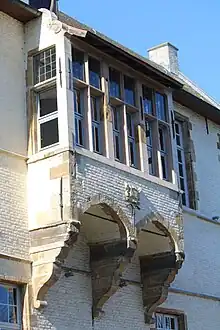Egmont's castle
Egmont's castle or the castle of (Lamoral count of) Egmont (Dutch: Egmontkasteel or Kasteel van Egmont) is a castle in the Belgian city of Zottegem. It has been declared a cultural heritage monument.[1][2]


History
The history of the castle goes back to the 11th century, when supposedly a motte-and-bailey castle was constructed by the rulers of Zottegem (the first one being mentioned in a charter (1083) was Rothardus). Around 1150 a stone keep was built and also a Romanesque aisleless church with a churchyard around it. The remains of that church were excavated in 1994. [3] At the end of the 12th century the big hall was rebuilt in brick by Walter II. Over the centuries the castle became the possession of different ruling families: the house of Antoing and the house of Melun (13th and 14th centuries), the house of Luxembourg-Fiennes (15th century). During the Revolt of Ghent the castle was taken in 1381. In 1452 the castle was besieged during another Revolt of Ghent. Around 1477 the castle was dismantled and rebuilt. On May 19, 1516 Charles V, Holy Roman Emperor visited the castle. From 1530 till 1707 the castle belonged to the House of Egmont, who started rebuilding the ancient castle into a luxury mansion. Lamoral, Count of Egmont inherited the castle from his brother in 1541. He had the Knights' Room (Ridderzaal) refurbished with a Renaissance oriel window and floor tiling from Antwerp.[4][5] In September 1566 Lamoral moved from the Egmont palace in Brussels to the castle;[6] On September 7, 1566, he wrote a letter to William of Orange from the castle.[7][8] After the beheading of Lamoral in 1568 on the Grand-Place of Brussels the castle was confiscated by the Spanish until 1577. During the Eighty Years' War the castle was damaged several times (1570, 1579, 1580). In 1645 and 1658 the castle suffered from French troops, as in 1671 and 1684 during the War of the Spanish Succession. French troops stayed in the castle during the Nine Years' War in 1690 and 1697.[9][10] Starting from 1707 the castle became the possession of a branch of the House of Pignatelli. Marie Claire of Egmont (1661-1714), the sister of the last male heir of Lamoral, count of Egmont was married to Niccolo Pignatelli.[11] After 1747 parts of the castle were demolished. In 1797 the castle was confiscated by the French. In 1815 it was sold to baron Lefèbvre from Tournai. He divided the castle into two parts. In 1867 a facade in Renaissance Revival architecture was erected. In 1957 and 1965 the city of Zottegem bought the two parts of the castle, which was used afterwards as a hospital, a school and art gallery. Since 1982 the castle houses the local library, for which a new building was added to the castle in 1986. Between 1994 and 1997 the castle was restored. The Knights' Room has been used for wedding ceremonies, concerts and conferences ever since. In 2022 a new restoration campaign started.
In the surrounding Egmont's park archaeological remains of the former church, castle walls, moats and (draw)bridge can be seen. A wrought-iron Egmont's statue (1872) by sculptor Jan-Robert Calloigne also stands in the park.
Images
 12th century
12th century 14th century
14th century 17th century
17th century Egmont's castle in 1629
Egmont's castle in 1629 Egmont's castle in 1641
Egmont's castle in 1641 Egmont's castle in 1853
Egmont's castle in 1853 Bridge of the castle in 1853
Bridge of the castle in 1853_31.jpg.webp) Beginning of the 20th century
Beginning of the 20th century Egmont's castle in 2019
Egmont's castle in 2019 Egmont's castle and surrounding Egmont's park
Egmont's castle and surrounding Egmont's park
References
- Flemish agency for cultural heritage
- City of Zottegem
- Van Eenhooge, D., De XIIde eeuwse castrale kapel in Zottegem (O.-Vl.), Archeologia mediaevalis, 19, 1996.
- Zottegem Egmontstad
- Majolicategels uit het kasteel van Egmont te Zottegem
- Afbeeldinge ende levensbeschryvinge van de Heeren en Graven van Egmondt samengesteld door Wim Schmelzer (2002). Digitale versie bijgewerkt in 2012, p. 447
- Briefwisseling van Willem van Oranje, Huygens ING
- Transcriptie Briefwisseling van Willem van Oranje, Huygens ING
- RAG, Land van Zottegem, nr. 648 rekeningen van ommestellingen Stad en Vrijheid van Zottegem 1690
- Gillis, P., Van Acker, A., Arnout Capitaine (ca. 1645-1729), meer over deze Zottegemse schepen, Handelingen XIV, 2009, Zottegems Genootschap voor Geschiedenis en Oudheidkunde, pag. 245-287
- Schmelzer, W., Levensbeschrijving van de graven en heren van Egmont, 2012, p. 503